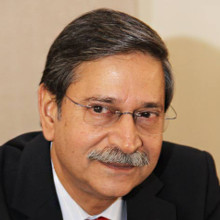[File picture of Air India Boeing 787-8 Dreamliner (VT-ANG) departs London Heathrow Airport, England, on 2nd July 2014. Via Wikimedia, Public Domain]
On a quiet afternoon in Ahmedabad, Air India Flight AI171—a Boeing 787 Dreamliner en route to London—crashed less than a minute after take-off. Over 260 lives were lost. One passenger survived.
For the nation, this wasn’t just a tragedy. It was a rupture—of public trust, of emotional safety, of our collective faith in systems we cannot see and people we never meet. And it has forced us to confront a question as old as leadership itself: When everything breaks, who shows up—and how?
This moment is not just about aviation safety. It is about leadership under fire. About grief, responsibility, and moral courage. What we are living through is a crucible—a moment of intense trial that can either destroy or transform. And how we respond will shape not only the future of Air India and the Tata group—but the soul of institutional trust in India.
The Nature of the Crucible
Crises of this kind don’t just test systems. They test values. The crucible is not the crash itself—it is what follows. Do leaders show up with presence or posture? With empathy or evasion? With truth or with tactics?
These are not simply operational dilemmas. They are ethical ones. And the public can sense the difference.
For Tata and Air India, the questions are multiplying: Should the 787 fleet be grounded while investigations unfold? How quickly should statements be made—and by whom? Should leaders first engage the public, the staff, or the grieving families? No option is risk-free. Every choice carries reputational and moral weight.
But leadership is not about waiting for certainty. It is about acting with integrity in the face of uncertainty. That is the true crucible.
A Legacy in the Balance
For Air India’s leadership, this tragedy comes during a delicate transformation under Tata group stewardship—a time when public goodwill was being rebuilt, brick by brick. The AI171 crash fractured that fragile narrative.
But for Tata, this is not just about an airline. This is about legacy. For over a century, the Tata name has stood for ethical business and national service. That symbolic weight makes this moment not just operational—but cultural.
In tragedy, institutions reveal who they really are. And Tata, long seen as a beacon of Indian corporate dharma, now faces its most public test of stewardship and sincerity.
Lessons from Tylenol: The Gold Standard of Crisis Leadership
To understand what exemplary crisis leadership looks like, we must turn to the 1982 Tylenol case.
When cyanide-laced capsules killed seven people in Chicago, Johnson & Johnson acted not just swiftly—but morally. They issued a nationwide recall of 31 million bottles, redesigned packaging, and communicated daily with the public. CEO James Burke did not hide behind procedures. He stood at the forefront, taking accountability—not because the law demanded it, but because trust did.
They didn’t wait for blame. They chose presence. They combined remediation (support for victims and families) with rectification (sweeping reforms to prevent future harm). The result? A benchmark in leadership under fire—and an eventual restoration of public trust.
A Tale of Two Responses
|
Dimension |
Tylenol (1982) |
Air India AI171 (2025) |
|
Trigger |
Product tampering (external) |
Aircraft crash post take-off |
|
Casualties |
7 deaths |
241 deaths, 1 survivor; additional civilian fatalities |
|
Initial Response |
Voluntary recall; CEO-led engagement |
Emergency ops; initial statements from chairman and CEO |
|
Leadership Presence |
Daily briefings, moral ownership |
Public statements delayed; visibility limited |
|
Transparency |
Full disclosure |
Updates reactive to public emotion |
|
Systemic Reform |
Packaging overhaul, industry precedent |
Rectification pending; investigations ongoing |
|
Public Perception |
Trusted despite crisis |
Mixed; grief amplified by perceived moral silence |
Grief in the Digital Age
One of the key differences between 1982 and 2025 is the role of social media.
Tylenol’s crisis played out in newspapers and on TV. Air India’s tragedy unfolded in real time—on phones, livestreams, and hashtags. The grief was immediate, unfiltered, and global. Victims were named before official briefings began. Misinformation spread. So did rage.
But this is not chaos, it is contemporary mourning. And leaders cannot ignore it. They must meet the moment where the public already is—with honesty, presence, and acknowledgment. Social media today is not a PR problem. It is the emotional terrain of leadership.
The Temptation to Scapegoat—and Why It Must Be Resisted
Every crisis breeds a desire to assign blame. But blame is not the same as accountability.
Johnson & Johnson resisted scapegoating. They owned the moment without passing the buck. That act alone restored moral legitimacy.
In contrast, the AI171 narrative was driven early by rumour, emotion, and speculation. Leadership voices were slow to emerge. And in the absence of presence, the public shaped its own conclusions.
This is the deeper crucible: Can an institution hold space for grief without hiding behind protocol? Can it take moral ownership while the facts are still emerging?
What True Legacy Looks Like
Leadership is not about having all the answers. It is about being there while those answers are found. And it is about doing the right thing even when the cost is high.
The Tylenol crisis cost Johnson & Johnson over $100 million. But it earned them something more valuable: trust.
Tata now faces a similar crossroads. The financial, reputational, and emotional stakes are immense. But so is the opportunity: to reaffirm its legacy not with posturing—but with presence. Not with platitudes—but with purpose.
This is not a moment to manage. This is a moment to honour.
From Fire to Renewal
Crucibles are not just moments of destruction. They are moments of potential renewal.
Tylenol transformed pain into reform. Air India and Tata can do the same—by listening, by acknowledging, and by acting decisively, visibly, and humanely.
Public trust, once broken, can be rebuilt. But only if institutions speak not just to the head, but to the heart.
Let this not be remembered only as the crash that shook a nation. Let it be remembered as the moment leadership showed up—with humility, with courage, and with the clarity to turn grief into legacy.
Note: Views expressed are personal.
Dig Deeper
Founding Fuel Live: Managing Corporate Reputation in the Digital Age: 18 takeaways on crisis management and trust building (Play time: ~ 60 mins)


